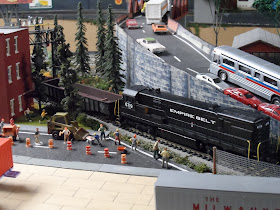I've been rethinking my freelanced Empire Belt Railroad's motive power roster after this PC U23C project and decided that the short line E.B.R.R. would be better served in my mind with GE FDL 12 cylinder prime mover U23Cs instead of the 3,000 hp GE FDL 16 cylinder U30Cs currently on the roster.

This project is strictly a renumbering of current EBRR Athearn BB U30Cs 6574 and 6576 into the Penn Central U23C number sequence and adding some yellow paint.
Some prototype U23C info:
General Electric U23C: A 2,300 HP engine designed for use in yard, transfer and heavy drag service meant to compete with the EMD SD38 and SD39. Production began in 1968 using an FDL 4 cycle 12 cylinder prime mover. The U23C was virtually identical to the U30C with the only variation being the U23C had two less hood doors per side. The U23C produced 85,000 pounds starting and 90,000 lbs continuous tractive effort. Designed to pull heavy loads the engine certainly had the tractive effort to do so.
The brain trust of the Empire Belt have gathered and debate the pluses and minuses of trading in the U30Cs for U23Cs. The more power, better fuel economy argument raged on thru the night.
Guess who won? Empire Belt U23C #6719 arrives from Selkirk. Parent company Penn Central had nineteen U23Cs, 6700-6718 on their roster. Subsidiary EBRR's U23Cs are assigned 6719 and 6720.
The E.B.R.R. trainmen prepare to board and bring the 6719 to their North Side Yard. The 6719 is maintenance based at Selkirk as subsidiary E.B.R.R. does not have engine facilities.
The 6719 is put right to work. The yellow safety paint and panels were a distinct feature of the PC U23Cs.
The 6719 shoves a cut of cars out North Side Yard.
After delivering three empty gondolas to Gervais Pipe on the right the 6719 is running long hood forward on the Industrial running track.
The 6719 heads toward Hohman Ave tower to work the west side industries. I'm not fond of the long hood forward running.
The GE shoves a cut of cars on the west side.
The six axle long wheel based GE is a tight fit on the west side but gets the job done.
EBRR U23C #6720 is fresh out of the shop and joins the 6719 at North Side Yard. A much better look for me!
The new dynamic duo enjoy a moment in the sun.
The 6720 is also maintenance based at Selkirk with the rest of the Penn Central GE fleet and EBRR fleet.
The U23Cs are at work pulling covered hoppers from Empire City Cargill during a recent experimental op.
The 6720 and 6719 starting out on a transfer run to the Penn Central Terminal Yard as part of an experimental layout op which I'll cover in an upcoming blog post.
Thanks for reading!!!
See ya soon!!!














Great work on the engines! If the PC would have been as efficient as Sir 1:1 John they may have lasted longer! I do like them running together and can still service any industry on the N.Y.C.T.L. in consist. I think the E.B. will be very happy with their new (revamped) motive power.
ReplyDeleteThank you for the compliments 1:1 Sir Neal!!! I think the U23Cs look much better running as a pair which eliminates the need to reverse their direction.
DeleteA well thought out roster change that I'm sure will work well for the Empire Belt! The pair look great together!
ReplyDeleteThank you Ralph!!! Same engines but the designation to a U23C just looks better and makes more sense to me as they operate on the layout.
DeleteHello John! Your latest U23C #6720 looks really good. It also looks good coupled up with the #6719.
ReplyDeleteI noticed you mentioned non-turbocharged U23C's. I have only known the GE 7FDL-12's as turbocharged. I have attached a link for the GE 7FDL-12 prime mover sound audio for you and others to enjoy.
https://www.youtube.com/watch?v=uKTSoQEtEkU
Thank you Robert R!!! Great sounds from the link. When I looked at the original U23C data for the PC project I noted the 12 cylinder had two blowers and the 16 cylinder had three which I think work differently from a turbo charger. I should have been more clear in the opening description which I'll correct.
Delete